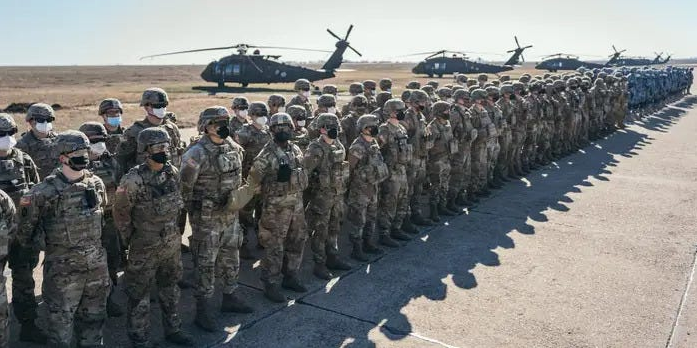Latest
Military Activity in the United States of America

In recent weeks, the United States has significantly ramped up its military activity both at home and abroad, signaling a period of heightened readiness and strategic maneuvering. From large-scale joint exercises across the Pacific and South America to domestic deployments and infrastructure upgrades, the U.S. Department of Defense is executing a multi-layered approach aimed at deterrence, force projection, and internal control.
Domestically, military forces have been mobilized in key urban areas such as Los Angeles, where federal troops, including elements of the National Guard and Marine Corps, have been deployed to assist in immigration enforcement and crowd control amid growing tensions. The decision has sparked controversy, with some lawmakers warning it could be a step toward invoking the Insurrection Act. Additionally, military bases in New Jersey and Indiana are being converted into temporary detention centers for migrants. Although Pentagon officials insist that this will not interfere with regular military operations, critics argue the move blurs the line between defense and domestic policy.
On the global front, the U.S. has launched REFORPAC 2025, the largest Pacific air exercise in its history. The operation involves over 300 aircraft and thousands of personnel spread across Hawai‘i, Guam, Japan, and surrounding international airspace. This comes alongside a trilateral air drill between the United States, South Korea, and Japan, featuring a U.S. B‑52H bomber flying over contested waters in a direct message to North Korea and China. These exercises reflect a sharpened focus on Indo-Pacific deterrence as geopolitical tensions rise in the region.
Meanwhile, U.S. forces have deployed to Panama to participate in PANAMAX‑Alpha, a week-long joint military exercise focused on protecting the Panama Canal. This strategic location is viewed as increasingly vulnerable due to growing Chinese influence in the region. At the same time, American troops are engaged in Keris Strike 25 in Malaysia and Talisman Sabre in Australia and Papua New Guinea—massive joint operations that include live-fire drills and jungle warfare training with allies such as Australia, Malaysia, and regional partners. Altogether, more than 35,000 troops from 19 countries are currently involved in operations designed to strengthen interoperability and readiness.
The U.S. military is also investing heavily in defense infrastructure. New naval maintenance hubs are being built in the Philippines to support allied operations in the South China Sea, and defense contractors have been awarded significant upgrades to radar systems, combat vehicle refurbishments, and shipyard improvements across the continental United States. In Europe, the Navy made headlines after a Los Angeles–class submarine docked in Iceland for the first time—an act widely interpreted as a warning signal to rival powers and a reaffirmation of U.S. commitment to Arctic defense.
On the weapons front, President Trump recently approved the transfer of advanced JASSM and Patriot missile systems to Ukraine, in a move expected to alter battlefield dynamics and increase pressure on Russia. Concurrently, the Pentagon hosted a high-level drone demonstration event, underscoring its ongoing shift toward unmanned aerial dominance in both surveillance and combat.
In sum, the United States is asserting its military presence across several key theaters simultaneously. Whether responding to rising international threats, supporting allies, or maintaining domestic order, the current wave of operations suggests a clear message: U.S. military readiness is entering a new, more assertive phase.
-

 Latest5 months ago
Latest5 months ago𝗔𝗹𝗹 𝗼𝗳 𝘁𝗵𝗲 𝗻𝗮𝗺𝗲𝘀 𝗺𝗲𝗻𝘁𝗶𝗼𝗻𝗲𝗱 𝗶𝗻 𝘁𝗵𝗲 𝗻𝗲𝘄 𝗝𝗲𝗳𝗳𝗿𝗲𝘆 𝗘𝗽𝘀𝘁𝗲𝗶𝗻 𝗱𝗼𝗰𝘂𝗺𝗲𝗻𝘁𝘀.
-

 Latest7 months ago
Latest7 months agoParis Hilton and Kanye Connected? “They Held Me Down, Spread My Legs…” [WARNING: Graphic]
-

 Latest6 months ago
Latest6 months agoHistoric Verdict Rocks America — Donald Trump Officially Convicted in a Turning Point No One Saw Coming
-

 Latest7 months ago
Latest7 months agoAlex Jones Exposes What’s Going On With Dan Bongino
-

 Latest5 months ago
Latest5 months agoProminent Republican Politician SWITCHES To Democrat Party
-

 Latest5 months ago
Latest5 months agoBREAKING: Supreme Court Responds to Gov. Greg Abbott’s Emergency Petition to REMOVE Runaway Democrat Leader
-

 Latest5 months ago
Latest5 months agoBOMBSHELL: President Trump Confirms Joe Biden Dead Since 2020!
-

 Latest5 months ago
Latest5 months agoBREAKING: President Trump drops a new message for America — and it changes everything.
